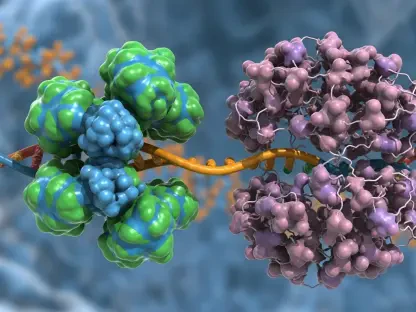In an era where software development races toward unprecedented complexity, AI-driven tools have become indispensable allies for developers worldwide, with a staggering statistic revealing that over 70% of internal engineers at leading tech firms now rely on AI assistance for coding tasks. This seismic shift in the industry sets the stage for GPT-5.1-Codex-Max, OpenAI’s latest agentic coding model, which promises to redefine efficiency and reasoning in programming. This roundup gathers diverse opinions, tips, and reviews from industry experts, developers, and tech analysts to unpack how this model is reshaping the landscape of AI coding tools. The aim is to provide a balanced perspective on its capabilities, challenges, and potential, offering readers a comprehensive view of this groundbreaking technology.
Unpacking the Capabilities of GPT-5.1-Codex-Max
Performance Benchmarks and Industry Reactions
Industry analysts have lauded GPT-5.1-Codex-Max for its remarkable performance metrics, which set it apart from competitors. Scoring 77.9% accuracy on SWE-Bench Verified and an impressive 79.9% on SWE-Lancer IC SWE, the model outperforms alternatives like Google’s Gemini 3 Pro. Many in the tech community view these results as a benchmark for what AI can achieve in handling complex software engineering tasks, emphasizing the model’s potential to streamline large-scale projects.
However, not all feedback is uniformly positive. Some software engineering consultants caution that while the numbers are impressive, they may not fully translate to niche or highly specialized coding scenarios. Concerns linger about whether such high accuracy rates hold up under real-world pressures where unique constraints often dominate.
A third viewpoint comes from data scientists who analyze AI tool adoption trends. They note that while the model’s performance is a step forward, the industry must grapple with the risk of over-reliance on automated solutions. This balance between trust in AI outputs and the need for human validation remains a hot topic in developer forums.
Technical Innovations Driving Efficiency
The model’s architectural advancements, particularly its compaction mechanism for managing context over millions of tokens, have drawn significant attention from tech innovators. This feature, which reduces thinking tokens by around 30%, is often cited as a game-changer for cost and latency in coding workflows. Many system architects highlight how this enables tasks like 24-hour multi-step refactors, previously unthinkable for AI tools.
On the flip side, scalability remains a concern among infrastructure specialists. While the compaction technology is revolutionary, some argue that in extremely high-volume environments, the model might still face bottlenecks. This perspective underscores a need for ongoing optimization to meet enterprise-level demands.
Additionally, software efficiency experts point out that the practical benefits of token reduction are undeniable, but they urge developers to weigh these against potential trade-offs in output granularity. The consensus seems to tilt toward cautious optimism, with many advocating for real-world testing to validate these technical claims across varied use cases.
Real-World Applications and Developer Feedback
Interactive Features and Workflow Integration
Developers who have integrated GPT-5.1-Codex-Max into their workflows via platforms like Codex CLI and IDE extensions often praise its real-time interactivity. Tools such as the CartPole simulator for reinforcement learning visualization demonstrate how the model bridges computation and implementation seamlessly. Many coders describe this as a significant leap, enabling dynamic problem-solving within a single session.
Yet, opinions diverge on accessibility and ease of adoption. Some freelance developers note that while the interactive features are powerful, the learning curve for leveraging them effectively can be steep, especially for those unfamiliar with agentic AI systems. This feedback suggests a gap in onboarding resources that could hinder widespread use.
A contrasting take comes from team leads at tech startups, who emphasize the model’s impact on productivity. Reports of a 70% increase in pull requests among internal teams using Codex weekly have fueled excitement about its potential to accelerate development cycles. However, they stress that human oversight remains crucial to ensure quality in collaborative settings.
Practical Tips for Maximizing Benefits
Seasoned programmers offer actionable advice for peers looking to adopt this tool. One common tip is to utilize transparent logs and test citations provided by the model to maintain control over code review processes. This practice helps mitigate risks of errors slipping through automated outputs, preserving project integrity.
Another suggestion from coding mentors focuses on starting with smaller, terminal-based tasks via Codex CLI to build familiarity before tackling larger projects. This gradual approach allows developers to understand the model’s reasoning patterns and adjust their workflows accordingly, avoiding potential overwhelm.
Lastly, tech educators advocate for pairing the model with structured team protocols. By assigning specific roles for AI assistance and human validation, development teams can harness the tool’s strengths while minimizing dependency. This balanced strategy is frequently recommended in online developer communities as a best practice.
Safety and Ethical Considerations
Cybersecurity Capabilities and Safeguards
Cybersecurity professionals have weighed in on the model’s capabilities for tasks like automated vulnerability detection, viewing it as a step forward in securing codebases. OpenAI’s strict sandboxing and default-disabled network access are often cited as robust measures that align with industry standards for risk mitigation.
Nevertheless, some security analysts express reservations about the evolving nature of AI threats. They argue that while current safeguards are strong, the rapid advancement of malicious tactics necessitates continuous updates to safety frameworks. This concern highlights a broader industry challenge of staying ahead of potential exploits.
A further perspective from ethical tech advocates emphasizes the importance of transparency in how these safeguards operate. They suggest that developers should have clearer insights into monitoring systems and disruption mechanisms to build trust in the tool’s deployment, especially in sensitive domains like cybersecurity.
Balancing Autonomy with Responsibility
Tech policy experts stress the dual focus on innovation and accountability embedded in the model’s rollout. The insistence on viewing GPT-5.1-Codex-Max as an assistant rather than a replacement for human expertise resonates widely, with many seeing this as a model for responsible AI integration in coding.
Differing opinions emerge from AI ethics panels, where some members worry that the line between assistance and autonomy could blur over time. They caution that without clear guidelines, developers might cede too much control, potentially leading to unintended consequences in critical applications.
Meanwhile, industry trainers highlight the need for ongoing education around ethical AI use. Their tip for organizations is to embed discussions on responsibility into developer training programs, ensuring that teams are equipped to navigate the moral implications of relying on such powerful tools.
Reflecting on the Broader Implications
Looking back, the diverse insights gathered in this roundup paint a multifaceted picture of GPT-5.1-Codex-Max as a transformative force in AI coding tools. Experts and developers alike recognize its superior performance, innovative context management, and real-time interactivity as milestones in software development. However, the discussions also reveal critical challenges, from scalability concerns to ethical dilemmas, that shape a more nuanced understanding of its role.
Moving forward, a key next step for the developer community involves actively engaging with platforms and resources to test and refine integration strategies for this model. Exploring industry forums and collaborative projects can provide deeper insights into overcoming adoption hurdles. Additionally, advocating for enhanced safety protocols and transparency in AI deployment will be vital to ensure trust and responsibility remain at the forefront. As the landscape of coding continues to evolve, staying proactive in learning and adaptation will empower professionals to harness the full potential of agentic AI systems while navigating their complexities with confidence.









